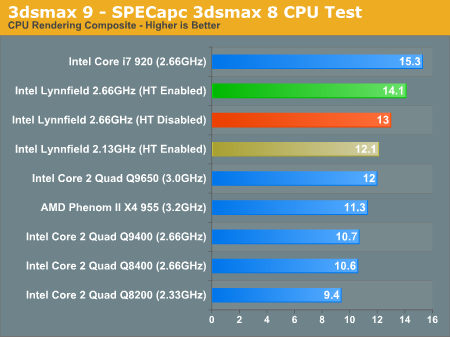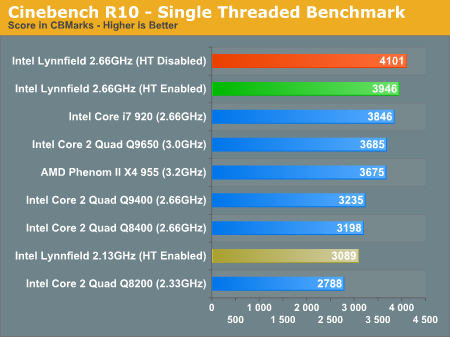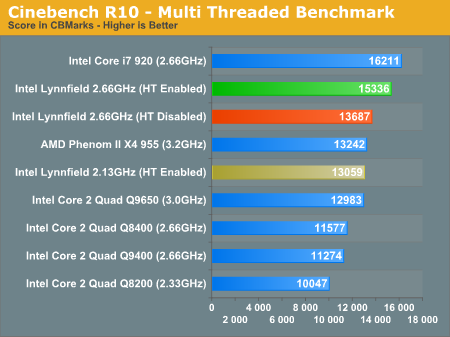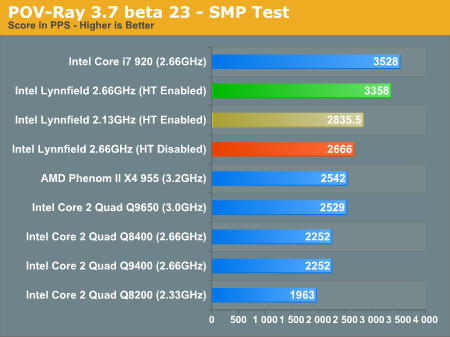The Lynnfield Preview: Rumblings of Revenge
by Anand Lal Shimpi on May 29, 2009 1:00 PM EST- Posted in
- CPUs
3dsmax 9 - SPECapc 3dsmax CPU Rendering Test
Today's desktop processors are more than fast enough to do professional level 3D rendering at home. To look at performance under 3dsmax we ran the SPECapc 3dsmax 8 benchmark (only the CPU rendering tests) under 3dsmax 9 SP1. The results reported are the rendering composite scores:

There are three key takeaway points here.
1) Hyper Threading allows the i7-920 to outperform the entry level Lynnfield by nearly 18%.
2) With HT disabled, the $196 Lynnfield is faster than the $316 Core 2 Quad Q9650. It's a true replacement for Penryn in the lineup.
3) Intel could release an even slower Lynnfield and, by enabling HT, offer a chip faster than all other Penryn and Phenom II based processors in the market.
Cinebench R10
Created by the Cinema 4D folks we have Cinebench, a popular 3D rendering benchmark that gives us both single and multi-threaded 3D rendering results.

The single threaded Cinebench test shows us just how powerful the Nehalem core is. Remember, we're looking at single-core performance here.
Without an aggressive turbo mode, the 2.66GHz Lynnfield sample is faster than a 3.0GHz Penryn. Even at 2.13GHz Lynnfield is able to perform like a 2.5GHz Penryn. This is a very flexible core.
These results also give you an indication of exactly how strong the dual-core Nehalem derivatives will be in notebooks late this year and into 2010.

Crank up the thread count and feel the frustration brew. The entry level Lynnfield won't have Hyper Threading enabled, and thus it'll only outperform the Phenom II 955 by 3.4%. Had Intel enabled the HT switch, Lynnfield would not only be 16% faster than AMD's best but it would also be only 5% slower than the i7-920.
POV-Ray 3.73 beta 23 Ray Tracing Performance
POV-Ray is a popular, open-source raytracing application that also doubles as a great tool to measure CPU floating point performance.
I ran the SMP benchmark in beta 23 of POV-Ray 3.73. The numbers reported are the final score in pixels per second.

We see a similar story in POV-Ray.










95 Comments
View All Comments
Seramics - Sunday, May 31, 2009 - link
Why is it that in test that demand intensive multi threading, the lynnfield loses out to bloomfield while in less intensive multithreaded or single threaded test, the lynnfield can equal bloomfield? Could it be that in intensive multithreading processing that work up more than 4 threads (thereby requiring the use of HT for better performance), it is able to use the extra memory bandwith provided by triple channel in the bloomfield platform? Maybe in situation where the software can really demand mutlple threading processing intensively, the bloomfield extra memory bandwith provide an edge. An easy way to test this is increasing the memory bandwith of lynnfield and/or decreasing memory bandwith of bloomfield n see wht happens in intensive multithreaded test. Im suspicious of this. Let me know wht u guys thinks.IntelUser2000 - Sunday, May 31, 2009 - link
The Turbo Modes for revealed for Lynnfield way before even Core i7's release.1 core: +5(+4 for non-HT version)
2 core: +3
4 core: +1
It may or may not be coincidence, but the Turbo speed of the highest clock Lynnfield is equal to the Turbo speed of the highest Core i7. The point is, I think since people will overclock the "enthusiast" i7's anyway, the Turbo doesn't need to be so high.
According to Intel, the benefits will be GREATER on smaller form factors, which means laptops will have even HIGHER increases.
RagingDragon - Sunday, May 31, 2009 - link
Hmmm... I'm not sure how much sense Lynnfield will make in the long term - at the high end you'll have Bloomfield on LGA-1366, and at the low end Clarkdale/Arrandale on LGA-1156. I'm not sure if there's enough room between them for Lynnfield, though I guess it does provide an easy upgrade option for inexpensive OEM systems which need to support Clarkdale.brightstar - Sunday, May 31, 2009 - link
I'll wait and see how this pans out, but as of right now the I5 sounds like the new Celery proc to meJS - Saturday, May 30, 2009 - link
"...to protect the innocent"I guess you really wanted to say "to protect my sources". I'm guessing they are not innocent at all, unless you actually stole the stuff from them. ;o)
mybook4 - Saturday, May 30, 2009 - link
The article mentions that Lynnfield will have a new turbo mode that clocks much higher. I was thinking of reasons why intel might put this feature into the mainstream i5 rather than making the feature exclusive to the i7. Then I remembered that the PCIe controller was integrated into the core.To overclock a multiplier locked i5, you would have to increase the base clock. Not sure, but I believe this would also overclock the PCIe controller (something which may not be as tolerant of overclocking).
This might explain why the new high end turbo mode would be included in the i5. You lose high overclocking potential (which would attract overclockers to i7), but in exchange, the i5 does decent overclocking for you.
pyn - Saturday, May 30, 2009 - link
is it possible that we will see turbo modes similar to lynnfield in gulftown? also, is intel going to release any 8 core / 16 thread nehalem processors targeted towards desktop systems or is the nehalem-ex likely to be the only 8 core nehalem we will see?mmpalmeira - Saturday, May 30, 2009 - link
Why did you use the Lynnfield in a 2.66Ghz configuration with HT on if there wont be models like that in the market?Anand Lal Shimpi - Saturday, May 30, 2009 - link
I did that to show what sort of performance having HT enabled is responsible for. Intel isn't making a 2.13GHz HT enabled Lynnfield either, but I ran those tests because they're interesting to look at :)Take care,
Anand
Drazick - Saturday, May 30, 2009 - link
Will the P55 support USB 3, SATA 3, UEFI?When will we see all those features in the chipsets, which for me, are much more important than the i5 by itself.
What about the new Chiopsets, are they SSD optimized?